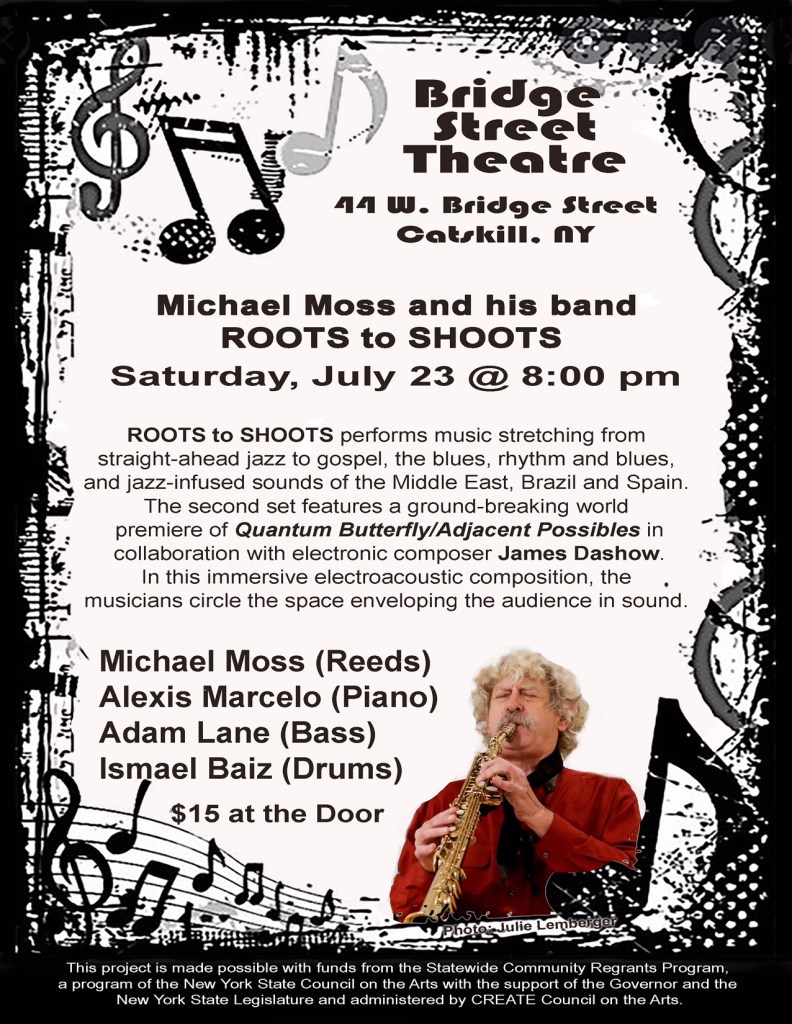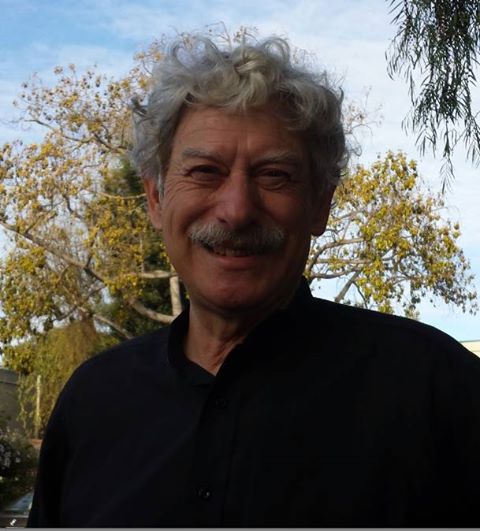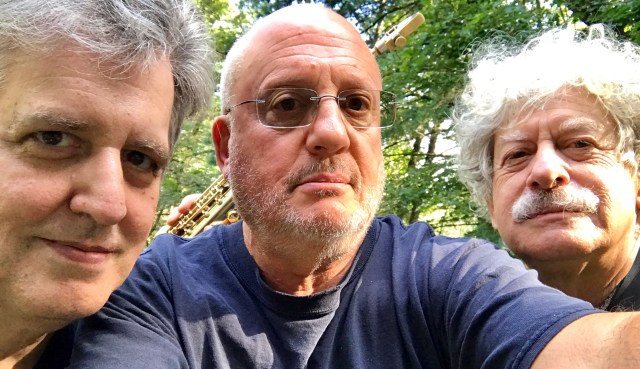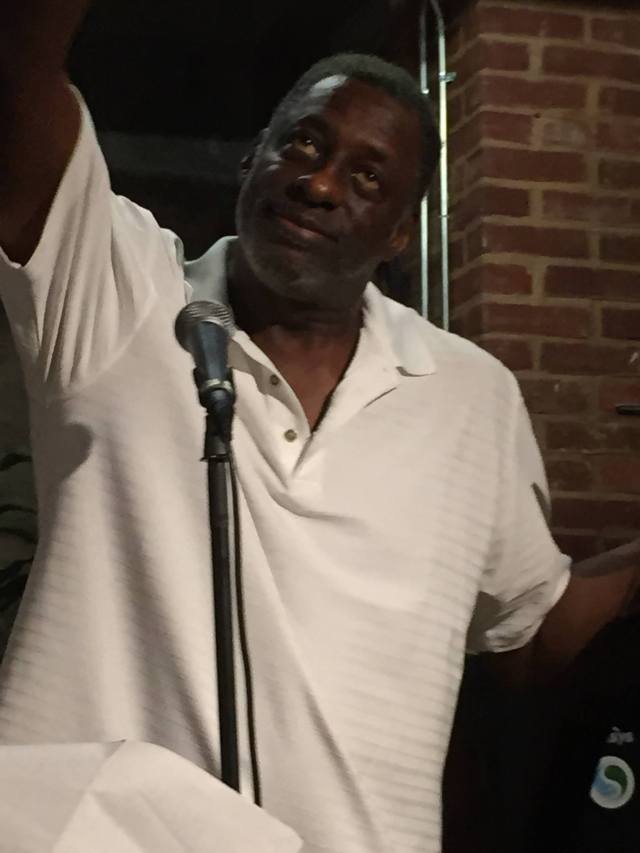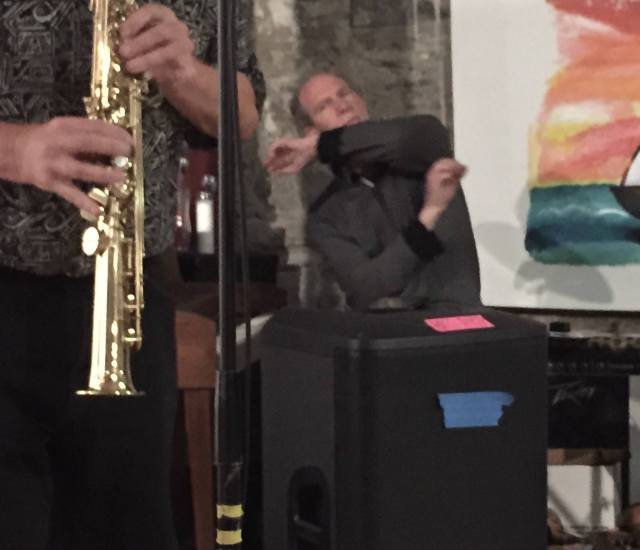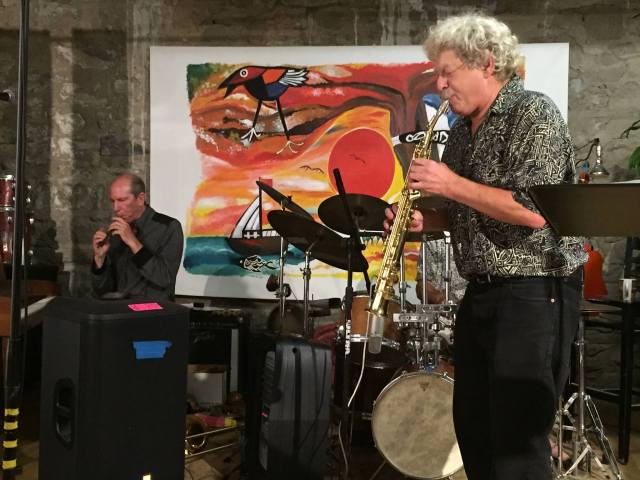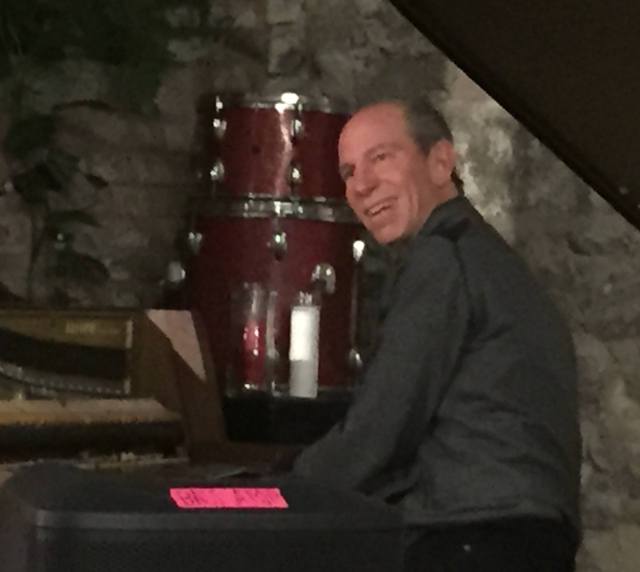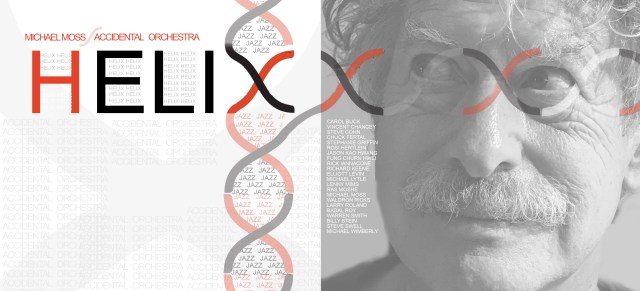 First let me thank the wonderful musicians who gave me so much inspiration in this project. When I first started thinking about composing a larger work I began searching for ways to gather together people who could realize the concept. Jason Kao Hwang, Carol Buck, and Steve Swell gave me leads to other improvising artists to join musicians with whom I had previously worked with who could interpret the music, solo, and make notes on a page into music, an art form I have dedicated my life to attempting to understand and express. Somehow people could feel their way into it so they accepted the challenge of working on new music with a person new to them.
First let me thank the wonderful musicians who gave me so much inspiration in this project. When I first started thinking about composing a larger work I began searching for ways to gather together people who could realize the concept. Jason Kao Hwang, Carol Buck, and Steve Swell gave me leads to other improvising artists to join musicians with whom I had previously worked with who could interpret the music, solo, and make notes on a page into music, an art form I have dedicated my life to attempting to understand and express. Somehow people could feel their way into it so they accepted the challenge of working on new music with a person new to them.
I cannot do more than hint at what intuition and creativity are, even though I wrote my doctoral dissertation on it. The music took me over. I would awaken with new musical ideas emerging from my unconscious, opening a portal so more musical ideas could come streaming in. I wanted every musician to solo—accompanied by fluctuating combinations of orchestral elements with varying colors, shades, and textures. When I began rehearsing the pieces, something else seemed to be hovering in the room that we all felt, and we abandoned petty thinking to honor the emotion of working together on a project bigger than ourselves. There was no personal drama; we all checked our egos at the door. After only three rehearsals we were ready to record the two pieces.
C# or Bb/See Sharp or Be Flat is a 32 bar contrapuntal jazzy jump swing tune I named to remind me not to fail to see where I was walking or I’d break my leg—again—which I did last winter when I tripped over a curb, which is one of the reasons why I call it the Accidental Orchestra. C# or Bb is a contrapuntal theme and variations mixing jazz, rhythm and blues, and the joy of dance. It is a way to let this band really swing! Throughout I refer to Norwegian Wood (Beatles), I Feel Good (James Brown), and Bags Groove (Modern Jazz Quartet) but do not resort to familiar big band trope. This is a type of string orchestra but with lots of jazz musicians pushing the boundaries.
The next piece, The Old One, is less traditional jazz, though quite traditional as religious music. I take the soul on an heroic journey, guided by the great books I read back in the ‘70s on the Qabbala, the Tibetan Book of the Dead, and the I Ching. I asked myself, how can music, spirit, quantum physics, and tradition describe the passage of the soul after death to sit beside the Godhead? The Old One is a part of a musical tradition stretching from the first ritual over the dead to the Mass in B Minor (J.S. Bach), Native American rites of passage into the spirit-world, through the Jewish mourner’s Kaddish and Buddhist Chemphar (funeral) ritual. The Old One is an initiation into sacred ground. Each movement represents the experiencing soul on its journey.
The Old One begins with Inception, which, like the movie Inception, surveys shifting mirrors of a distorted reality pregnant with possibility, establishing a disturbing atmosphere. Next, I musically II “Bridge” the gap between this life and the next. The middle movement, III Tree of Life/Qabbala, expresses the mysterious and foreboding, yet ultimately ecstatic emotion of the pre-psychological mythical tradition spoken of only to the initiate. We progress through theTibetan mysticism expressed in IV Bardo Thödol/Angels and Devils//Wizards and Deatheaters by creating transformative instrumental ornamentations and emotion. I picture musically the ultimate objective as strong and yet yielding musical esoteric realization of Creation so as to end up with the soul sitting at the foot of God who sits upon the Throne of Gold as spoken of in the Qabbala.
It is not easy to form your own orchestra from scratch. I have a sense of urgency to complete this complex project. I assembled the best improvisers in New York and Philadelphia to play two extended through-composed suites that involve extensive individual and group soloing. The credits of each of these musicians are long and profound. I selected people who worked together in past configurations and then compositionally structured solo sections to combine these previously existing groups so as to reveal what long years of creative collaboration can produce. We prepared scores and parts, rehearsed and recorded the two pieces at Systems 2, an amazing recording studio in Brooklyn, NY, then mixed and mastered the recording by the incredible sound engineer Jon Rosenberg.
Playing in New York City for over 49 years, I meet extraordinary cats from all over the world. All the artists have agreed to work for less than their usual fee because we are collaborating for a greater spiritual good though they need to be paid again if support can be engendered. They experience the music and have bonded as they work out problems to make notes on paper into music. I push them to utilize structure familiar and strange as they solo individually, in subgroups I form and dissolve, and as a tutti ensemble that is strange and miraculous.
Members of the Accidental Orchestra: Jason Kao Hwang, Rosi Hertlein, Fung Chern Hwei (violins), Stephanie Griffin (viola), Lenny Mims and Carol Buck (cellos), Steve Swell (trombone), Vincent Chancey (French horn), and Waldron Mahdi Ricks (trumpet), Richard Keene (oboe), Elliott Levin (flute, tenor saxophone), Ras Moshe Burnett (soprano and tenor saxophones), Michael Lytle (bass clarinet), Michael Moss (Bb clarinet), Steve Cohn (piano), Billy Stein (guitar), Rick Iannacone (ambient guitar), Larry Roland (string bass), Warren Smith (percussion, vibraphones), Badal Roy (tabla), Chuck Fertal (drums), and Michael Wimberly (djembe, African bells and percussion).
What I call a renaissance jazz orchestra consists of a horn, brass, string, and rhythm section and harkens back to orchestras initiated 400 hundred years ago in Europe. I discovered the concept in the 1970s when I liberated a book describing the Renaissance Orchestra owned by my father concert pianist H. Baron Moss which he no doubt obtained when he attended Eastman School of Music and Julliard. I had written and performed in larger jazz ensembles but always liked working with the few string players who could improvise. I trace the concept of a large group like this to the 1970s when, as President of Free Life Communication, a musicians’ cooperative in NYC, I was one of the first jazz musicians to use an improvising string section of extraordinary violinists, violists, and cellists in my group Free Energy. When I formed the group Free Energy I was able to have the makings of a small orchestra which I subverted so as to play free jazz by adding a jazz rhythm section using multiple drummers in addition to traps.
In January 2016, I fractured my left femur by tripping over a curb. Homebound for months, I composed a piece entitled C# or Bb, See Sharp or Be Flat, to memorialize my accident. It grew from a 32 bar phrase into a contrapuntal theme and variations for 22 musicians. I then composed The Old One in five movements: I Inception, II Bridge, III Qabbala/Tree of Life, IV Bardo Thodol//Angels and Devils/Wizards and Deatheaters, and V The Mind of God/StreamingàThrone of Gold. To perform these pieces I have formed the Accidental Orchestra, named after my accident, with sub-meanings of musical accidentals, John Cage chance music, and the physics string theory of quantum superposition in 11 dimensions. The Old One, named after Einstein’s penchant for referring to God as the Old One, follows a musical transmigration of souls transitioning from death to rebirth as the soul progresses from one state to another on the way to reincarnation or attainment of its Buddha nature as described in The Tibetan Book of the Dead, and alternatively describing the passage of the soul from the death of the body to sitting at the feet of God as described in the Qabbala. Composers have followed this path to elevate audiences to a higher level of spirituality through music for centuries in all cultures.
I recorded the Accidental Orchestra Monday, Oct. 10—Columbus Day—in Systems II, an extraordinary recording studio in Brooklyn where guitarist Billy Stein and I recorded Intervals (2013), engineered by Jon Rosenberg. It is being released in 2017 on 4th Stream Records, an independent label I initiated in the 1970s. Graphic artist and FIT Professor Karen Santry and Timoshii Paterson of the Jedd Group used photographer/video editor Bernard Feinsod’s visual documentation (photography and video) as a springboard to create graphics for the CD. Poet Steve Dalachinsky composed non-linear abstract liner notes. Publicist Jim Eigo of Jazz Promo Services is on board to get reviews and press for this amazing project. Thanks go also to assist/arranger/composer/musicologist/music director-conductor John Shea for assisting me on arrangement, score and part preparation, and for conducting this incredible ensemble, sound engineer Jon Rosenberg who did a masterful job recording, mixing and mastering, and to video editor and photographer Bernard Feinsod who shot the project.
Music that appeals to a wide range of people has to come from a tradition, a history, a culture, and a spirit-quest. Tunes—I’ve been writing my entire life. Large groups—I led 100+ musicians at NYU for the Jazz Composers Orchestra Association (JCOA), for the entire membership of Free Life Communication, and at WBAI-FM in my compositions. My spirit-quest begins with the first bone flute, extends through Renaissance chorales, Mozart, Beethoven, Bartok, Stravinsky, Charlie Parker, Thelonius Monk, John Coltrane, Eric Dolphy, to John Cage, Milton Babbitt, Elliott Carter, and to experimental acoustic/electronic composers. If you as an audience have heard the blues, danced to the beat, you have participated. If you find repose in serious music this will appeal. I am extending an American musical heritage, stretching from Charles Ives, Scott Joplin, Robert Johnson, Fats Waller, Louis Armstrong, Dizzy Gillespie, Cecil Taylor and Anthony Braxton into the future. From the perspective of world music I draw from the fundamental elements of folk music from around the world to structure jazz offshoots by abstracting rhythm, ragas, modes, and instrumentation. The audience I want to reach includes the core of New York based musicians to an audience of New Yorkers and ubternational musicians and fans willing to challenge themselves and their ears in all musical disciplines. My music is part of a history, a tradition. It is big, emotional, and takes you on a journey, an arc of melody, to leave you in another state, better than before, uplifted. We as musicians participate in this daily—we want to share.
Michael Moss, Ph.D.
